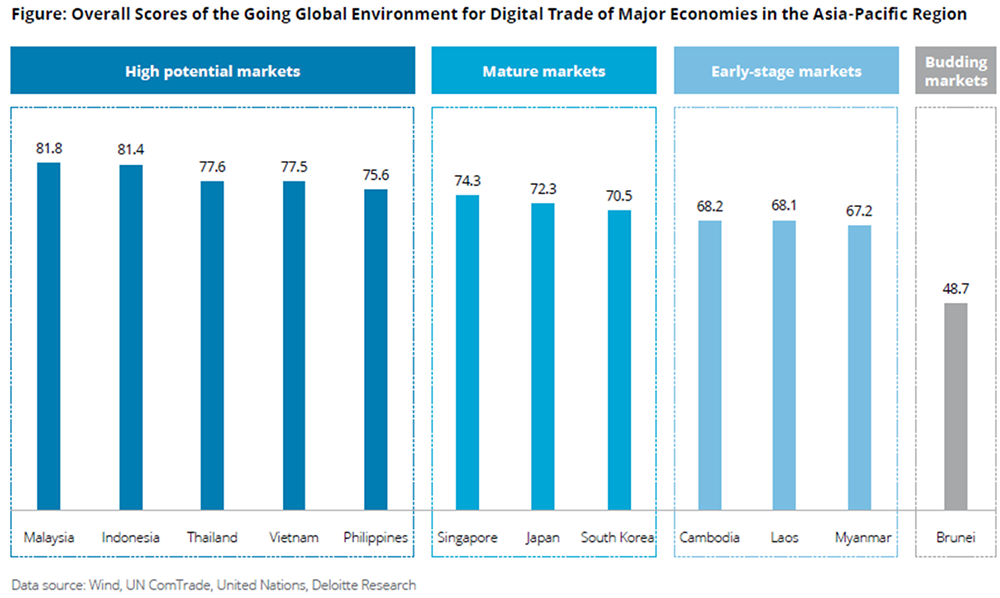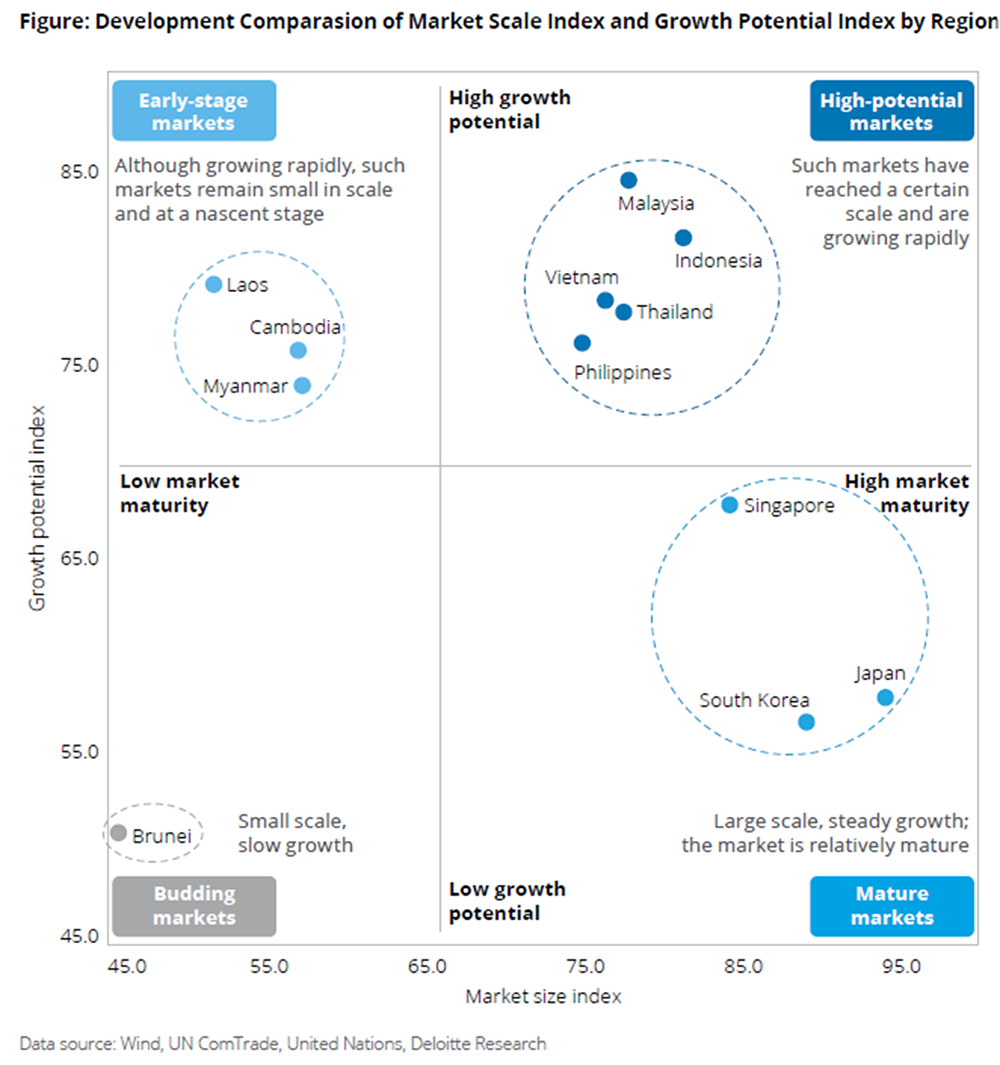Article
Deloitte and WorldFirst jointly launched Going-Global Seizing the Next Great Opportunity in Digital Trade
Published date: 29 August 2024
Deloitte and WorldFirst released the Going-Global Seizing the Next Great Opportunity in Digital Trade. The report focuses on global digital trade and analyzes in detail the growth momentum of digital trade in Asia-Pacific. According to the report, In 2023, the Asia-Pacific region’s import and export trade in goods accounted for approximately 40% of global trade activities, reaching nearly USD18 trillion. It is projected to reach USD18.5 trillion in 2024, reflecting a growth of 5.1%, outpacing the World Trade Organization’s global trade growth forecast of 2.6%.
Key findings:
Asia-Pacific trade maintains growth momentum with strengthening regional cooperation
The sustained vibrancy of Asia-Pacific trade and the continuous strengthening of regional cooperation can be attributed to several factors. Firstly, with economic growth and rising income levels, the Asia-Pacific region has evolved beyond its role as a manufacturing hub to become a new global consumption center in recent years, making intra-regional trade routes increasingly significant. RCEP, which came into effect in 2022, is currently the world’s largest free trade agreement, with all members committed to lowering tariffs, opening markets, and reducing standard barriers, thus contributing new momentum to global economic cooperation. Moreover, the rapid development and application of digital technologies provide more market participants with opportunities to engage in global value chains and are revolutionizing enterprises’ research and development (R&D), production, and marketing models.
With the benefits of RCEP policies, Chinese businesses continue to expand their overseas operations. In the first half of 2024, the overall transaction volume of “micro multinational enterprises” in RCEP countries and regions increased by 190% year-on-year. Additionally, the transaction volume in emerging markets such as the Middle East, Latin America, and Africa also grew by more than 100% year-on-year.
Asia-Pacific markets with different potential for enterprises going overseas, Singapore ranks as a mature market in Southeast Asia
The Asia-Pacific region is one of the fastest-growing areas for the global digital economy, with digital trade rapidly developing across various dimensions. However, countries within the Asia-Pacific region vary in their stages of economic development and levels of digitalization. This report analyzes and compares the going global environment for digital trade of major economies in the Asia-Pacific region from two dimensions: growth potential and market scale and develops the Going Global Potential Index of Asia-Pacific Digital Trade for major countries in the region.
Based on the evaluation system, the major economies in Asia can be categorized into four types regarding their going global environment for digital trade: high potential markets, mature markets, early-stage markets and budding markets. High potential markets include Indonesia, Malaysia, Vietnam, Thailand, and the Philippines. Mature markets include Singapore, Japan, and South Korea, and early-stage markets include Cambodia, Myanmar, and Laos, and Brunei is a budding market.


Singapore, the only mature market in the Southeast Asia region to make the list, is as a central city drives the prosperity of digital trade. Singapore’s position as a global commercial center and an international logistics hub underpins the foundation of digital trade. As one of the most forward looking nations in the global digital economy, Singapore actively engages in the development of the digital trade system, and continually expands its digital trade partnerships. Although Singapore’s domestic e-commerce market is not large, there are comprehensive e-commerce platforms, the headquarters of two cross-border e-commerce giants in Southeast Asia, Shopee and Lazada, are located in Singapore, with their influence extending across the whole Southeast Asian region . According to Statista, Singapore’s e-commerce market size is projected to reach USD8.3 billion by 2028. In recent years, Singapore has introduced numerous policy initiatives aimed at advancing its digital payment ecosystem while opening up international markets. The improvement of the digital payment experience, and the convenience of cross-border payments will bolster Singapore’s competitiveness in the digital trade sector.
The digital economy is improving and accelerating the development of digital trade
Digital technologies optimizes all important aspects of cross-border trade, for example, cross-border payment providers have expanded from basic payment services to offering comprehensive cross-border financial services, further enhancing the experience of cross-border sellers. From a technological perspective, Generative AI and Software as a Service (SaaS) are playing the most significant roles. On the one hand, businesses leverage the benefits of Generative AI in content creation to reduce costs and increase efficiency in marketing and sales; on the other hand, SaaS technology expands to both front and back ends, creating an integrated service model that includes traffic acquisition, advertising, and product design at front end, as well as payment processing and logistics at back end, providing a broader opportunity for independent website operators.
Brand strength, channel efficiency, and operational capability have become crucial opportunities for micro multinational enterprises
The advancements in digital technologies have lowered the barriers for SMEs to enter the cross-border e-commerce market. A large number of entrepreneurs and small businesses from the Asia-Pacific region have ventured into cross-border e-commerce, operating in multiple markets and becoming “micro multinational enterprises”. These entities provide diverse “locally made” and light customization services to global buyers. With the further improvement of cross-border e-commerce infrastructure and ecosystem, especially as major cross-border e-commerce platforms continue to expand their service scope, introduce diversified service models, and actively adjust their merchant recruitment policies, more “micro multinational enterprises” are experiencing rapid growth. Their product capabilities and user bases have significantly increased, gradually developing into “cross-border little giant enterprises”.
While empowering global sellers on cross-border e-commerce platforms, more and more industry players are realizing that the current market dividends are gradually diminishing, and competition is shifting from new businesses to existing ones. Consequently, brand strength, channel efficiency, and operational capability have become crucial opportunities to break the competitive landscape. In the survey, a quarter of respondents indicated that branding and premiumization of products constitute the main driver of future growth, to cater to the market and consumers to achieve localized development and further rapid market penetration through localization has become a key competitive edge, particularly in emerging e-commerce markets. According to the survey, over 70% of respondents indicated that they are currently engaging in or planning to engage in localizd operations overseas, with the top three areas of focus being product localization, team localization, and marketing localization.
On the other hand, the trend of developing self-operated platforms (independent websites) is growing, with a combined layout of platforms and independent websites emerging. In the survey, more than half of the merchants have already established independent websites, and 36% plan to do so. More traffic is being directed towards branded independent websites, enhancing the supply chain through deep connections with consumers, including product design, development, and brand marketing.
